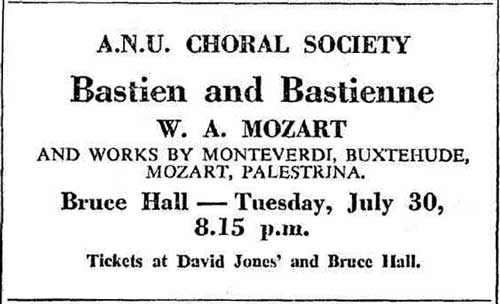

SCUNA history » Concerts » 1963
Advertisement | Programme | Review | Notes

A.N.U. CHORAL SOCIETY
Bastien and Bastienne
W. A. MOZART
AND WORKS BY MONTEVERDI, BUXTEHUDE,
MOZART, PALESTRINA.
Bruce Hall - Tuesday, July 30,
8.15 p.m.
Tickets at David Jones' and Bruce Hall.
The advertisement was repeated on 26, 27, 29 and 30 July 1963. On 30 July the place and time were changed to BRUCE HALL, TONIGHT at 8.15.
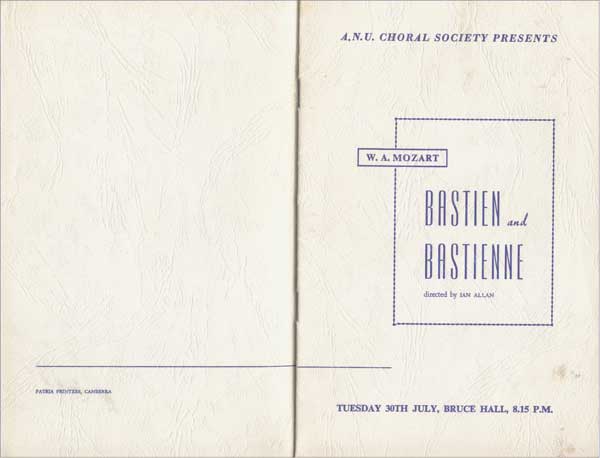
[Left hand side] PATRIA PRINTERS, CANBERRA
[Right hand side] A.N.U. CHORAL SOCIETY PRESENTS
W.A. MOZART
BASTIEN and BASTIENNE
directed by IAN ALLAN
TUESDAY 30TH JULY, BRUCE HALL, 8.15 P.M.

GOD SAVE THE QUEEN
CANTATE DOMINO CANTICUM NOVUM - Buxtehude
CRUCIFIXUS and ET RESURREXIT - Monteverdi
MISSA BREVIS - Palestrina
LAUDATE DOMINUM - Mozart
INTERVAL
BASTIEN AND BASTIENNE - Mozart
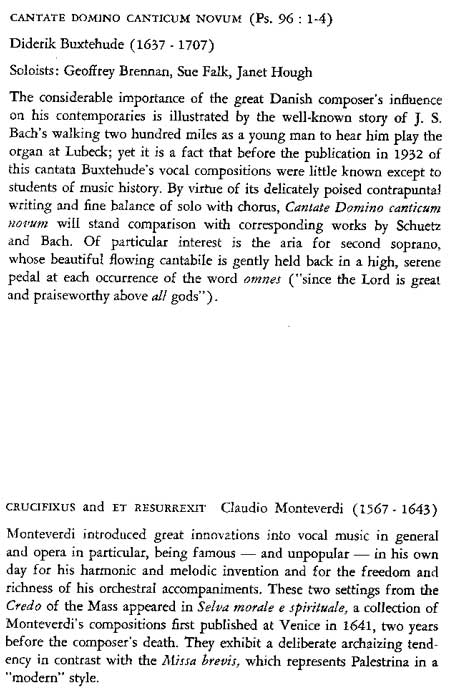
CANTATE DOMINO CANTICUM NOVUM - (Ps. 96 : 1-4)
Diderik Buxtehude (1637 - 1707)
Soloists: Geoffrey Brennan, Sue Falk, Janet Hough
The considerable importance of the great Danish composer's influence on his contemporaries is illustrated by the well-known story of J.S. Bach's walking two hundred miles as a young man to hear him play the organ at Lubeck; yet it is a fact that before the publication in 1932 of this cantata Buxtehude's vocal compositions were little known except to students of music history. By virtue of its delicately poised contrapuntal writing and fine balance of solo with chorus, Cantate Domino canticum novum will stand comparison with corresponding works by Schuetz and Bach. Of particular interest is the aria for second soprano, whose beautiful flowing cantabile is gently held back in a high, serene pedal at each occurrence of the word omnes ("since the Lord is great and praiseworthy above all gods").
CRUCIFIXUS and ET RESURREXIT Claudio Monteverdi (1567-1643)
Monteverdi introduced great innovations into vocal music in general and opera in particular, being famous - and unpopular - in his own day for his harmonic and melodic invention and for the freedom and richness of his orchestral accompaniments. These two settings from the Credo of the Mass appeared in Selva morale e spirituale, a collection of Monteverdi's compositions first published at Venice in 1641, two years before the composer's death. They exhibit a deliberate archaizing tendency in contrast with the Missa brevis, which represents Palestrina in a "modern" style.
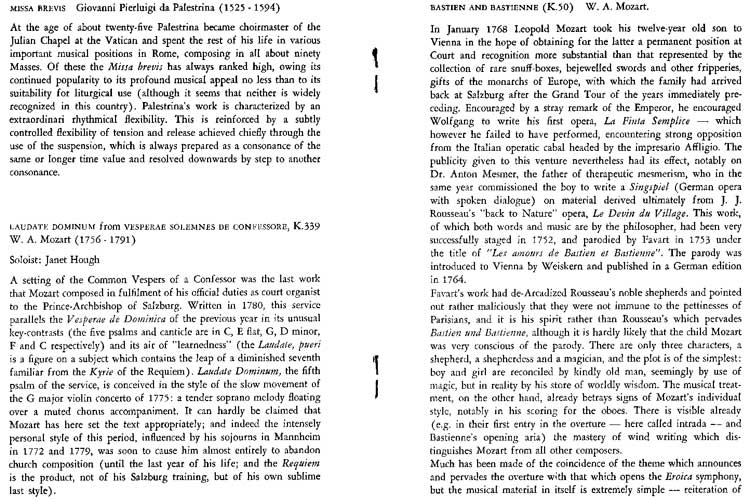
MISSA BREVIS Giovanni Pierluigi da Palestrina (1525-1594)
At the age of about twenty-five Palestrina became choirmaster of the Julian Chapel at the Vatican and spent the rest of his life in various important musical positions in Rome, composing in all about ninety Masses. Of these the Missa brevis has always ranked high, owing its continued popularity to its profound musical appeal no less than to its suitability for liturgical use (although it seems that neither is widely recognized in this country). Palestrina's work is characterized by an extraordinari [sic] rhythmical flexibility. This is reinforced by a subtly controlled flexibility of tension and release achieved chiefly through the use of the suspension, which is always prepared as a consonance of the same or longer time value and resolved downwards by step to another consonance.
LAUDATE DOMINUM from VESPERAE SOLEMNES DE CONFESSORE, K.339
W. A. Mozart (1756-1791)
Soloist: Janet Hough
A setting of the Common Vespers of a Confessor was the last work that Mozart composed in fulfilment of his official duties as court organist to the Prince-Archbishop of Salzburg. Written in 1780, this service parallels the Vesperae de Dominica of the previous year in its unusual key-contrasts (the five psalms and canticle are in C, E flat, G, D minor, F and C respectively) and its air of "learnedness" (the Laudate, pueri is a figure on a subject which contains the leap of a diminished seventh familiar from the Kyrie of the Requiem). Laudate Dominum, the fifth psalm of the service, is conceived in the style of the slow movement of the G major violin concerto of 1775: a tender soprano melody floating over a muted chorus accompaniment. It can hardly be claimed that Mozart has here set the text appropriately; and indeed the intensely personal style of this period, influenced by his sojourns in Mannheim in 1772 and 1779, was soon to cause him almost entirely to abandon church composition (until the last year of his life; and the Requiem is the product, not of his Salzburg training, but of his own sublime last style).
BASTIEN AND BASTIENNE (K.50) W. A. Mozart
In January 1768 Leopold Mozart took his twelve-year old son to Vienna in the hope of obtaining for the latter a permanent position at Court and recognition more substantial than that represented by the collection of rare snuff-boxes, bejewelled swords and other fripperies, gifts of the monarchs of Europe, with which the family had arrived back at Salzburg after the Grand Tour of the years immediately preceding. Encouraged by a stray remark of the Emperor, he encouraged Wolfgang to write his first opera, La Finta Semplice -- which however he failed to have performed, encountering strong opposition from the Italian operatic cabal headed by the impresario Affligio. The publicity given to this venture nevertheless had its effect, notably on Dr. Anton Mesmer, the father of therapeutic mesmerism, who in the same year commissioned the boy to write a Singspiel (German opera with spoken dialogue) on material derived ultimately from J. J. Rousseau's "back to Nature" opera, Le Devin du Village. This work, of which both words and music are by the philosopher, had been very successfully staged in 1752, and parodied by Favart in 1753 under the title of "Les amours de Bastien et Bastienne". The parody was introduced to Vienna by Weiskern and published in a German edition in 1764.
Favart's work had de-Arcadized Rousseau's noble shepherds and pointed out rather maliciously that they were not immune to the pettinesses of Parisians,and it is his spirit rather than Rousseau's which pervades Bastien and Bastienne, although it is hardly likely that the child Mozart was very conscious of the parody. There are only three characters, a shepherd, a shepherdess and a magician, and the plot is of the simplest: boy and girl are reconciled by kindly old man, seemingly by use of magic, but in reality by his store of worldly wisdom. The musical treatment, on the other hand, already betrays signs of Mozart's individual style, notably in his scoring for the oboes. There is visible already (e.g. in their first entry in the overture -- here called intrada -- and Bastienne's opening aria) the mastery of wind writing which distinguishes Mozart from all other composers.
Much has been made of the coincidence of the theme which announces and pervades the overture with that which opens the Eroica symphony, but the musical material in itself is extremely simple -- reiteration of
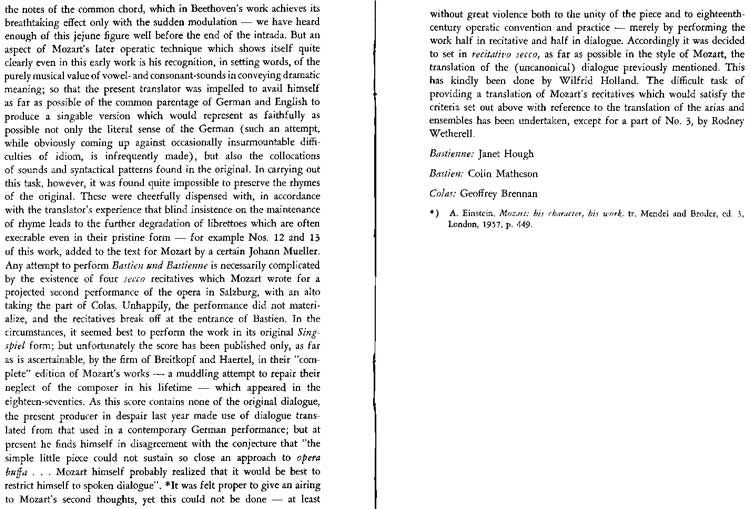
the notes of the common chord, which in Beethoven's work achieves its breathtaking effect only with the sudden modulation -- we have heard enough of this jejune figure well before the end of the intrada. But an aspect of Mozart's later operatic technique which shows itself quite clearly even in this early work is his recognition, in setting words, of the purely musical value of vowel- and consonant-sounds in conveying dramatic meaning; so that the present translator was impelled to avail himself as far as possible of the common parentage of German and English to produce a singable version which would represent as faithfully as possible not only the literal sense of the German (such an attempt, while obviously coming up against occasionally insurmountable difficulties of idiom, is infrequently made), but also the collocations of sounds and syntactical patterns found in the original. In carrying out this task, however, it was found quite impossible to preserve the rhymes of the original. These were cheerfully dispensed with, in accordance with the translator's experience that blind insistence on the maintenance of rhyme leads to the further degradation of librettoes which are often execrable even in their pristine form -- for example Nos. 12 and 13 of this work, added to the text for Mozart by a certain Johann Mueller.
Any attempt to perform Bastien and Bastienne is necessarily complicated by the existence of four secco recitatives which Mozart wrote for a projected second performance of the opera in Salzburg, with an alto taking the part of Colas. Unhappily, the performance did not materialize, and the recitatives break off at the entrance of Bastien. In the circumstances, it seemed best to perform the work in its original Singspiel form; but unfortunately the score has been published only, as far as is ascertainable, by the firm of Breitkopf and Haertel, in their "complete" edition of Mozart's works -- a muddling attempt to repair their neglect of the composer in his lifetime -- which appeared in the eighteen-seventies. As this score contains none of the original dialogue, the present producer in despair last year made use of dialogue translated from that used in a contemporary German performance; but at present he finds himself in disagreement with the conjecture that "the simple little piece could not sustain so close an approach to opera buffa ... Mozart himself probably realized that it would be best to restrict himself to spoken dialogue".* It was felt proper to give an airing to Mozart's second thoughts, yet this could not be done -- at least
without great violence both to the unity of the piece and to eighteenth-century operatic convention and practice -- merely by performing the work half in recitative and half in dialogue. Accordingly it was decided to set in recitativo secco, as far as possible in the style of Mozart, the translation of the (uncanonical) dialogue previously mentioned. This has kindly been done by Wilfrid Holland. The difficult task of providing a translation of Mozart's recitatives which would satisfy the criteria set out above with reference to the translation of the arias and ensembles has been undertaken, except for a part of No. 3, by Rodney Wetherell.
Bastienne: Janet Hough
Bastien: Colin Matheson
Colas: Geoffrey Brennan
*) A. Einstein, Mozart: his character, his work, tr. Mendel and Broder, ed. 3, London, 1957, p. 449.
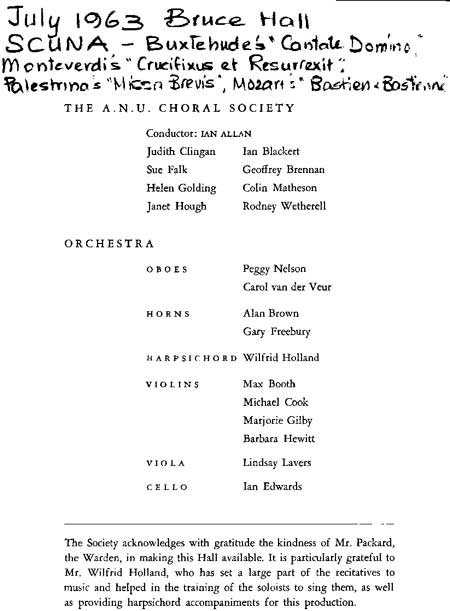
| In Judith Clingan's handwriting: July 1963 Bruce Hall SCUNA - Buxtehude's "Cantate Domino", Monteverdi's "Crucifixus et Resurrexit", Palestrina's "Missa Brevis", Mozart's "Bastien & Bastienne" |
||
| THE A.N.U. CHORAL SOCIETY | ||
| Conductor: IAN ALLAN | ||
| Judith Clingan | Ian Blackert | |
| Sue Falk | Geoffrey Brennan | |
| Helen Golding | Colin Matheson | |
| Janet Hough | Rodney Wetherell | |
| ORCHESTRA | ||
| OBOES | Peggy Nelson | |
| Carol van der Veur | ||
| HORNS | Alan Brown | |
| Gary Freebury | ||
| HARPSICHORD | Wilfrid Holland | |
| VIOLINS | Max Booth | |
| Michael Cook | ||
| Marjorie Gilby | ||
| Barbara Hewitt | ||
| VIOLA | Lindsay Lavers | |
| CELLO | Ian Edwards | |
______________________________________________________________
The Society acknowledges with gratitude the kindness of Mr. Packard, the Warden, in making this Hall available. It is particularly grateful to Mr. Wilfrid Holland, who has set a large part of the recitatives to music and helped in the training of the soloists to sing them, as well as providing harpsichord accompaniments for this production.

Concert Of Rare Vocal Works
It is not often that vocal works of the great 16th and 17th century composers are heard on the concert platform. An enthusiastic audience at Bruce Hall last night listened to some beautiful singing by members of the University Choral Society, directed by Ian Allen,4 and assisted by Wilfred Holland5 and a small orchestra.
Their four choral works featured the Italians Palestrina and Monteverdi, the Danish organist Buxtehude, and the Austrian Mozart, whose early operetta Bastien et Bastienne also constituted the second half of the programme.
The four part Missa Brevis of Palestrina is renowned for its beauty of effect as well as its ingenious structure. The five singers, unaccompanied, presented it with suitable devotion, nice balance and smoothness, securing particularly good results in the Benedictus and the Agnus Dei. It was an excellent illustration of the now vanished ecclesiastical polyphonic style that culminated with Palestrina.
After the preoccupation with very lovely, but serious, ecclesiastical music, it was an interesting change to have presented - and this very capably - Mozart's operetta, Bastien et Bastienne, written at the age of 12.
The story is of the simplest character, based on an earlier pastoral work of Rousseau, parodied in Vienna by the comedian Weiskern. It was commissioned from Mozart by Dr. Mesmer, of hypnotic fame.
Magician
It presents two lovers who quarrel and are reconciled through the mediation of a shepherd, who poses as a magician.
The short overture, the first theme of which resembles that of Beethoven's Eroica symphony, was pleasantly played by the small orchestra. Wilfred Holland, who had set to music the dialogue portions of the piece, also accompanied these skilfully on his harpsichord.
The part of Bastienne was taken by Janet Hough, who sang in a clear soprano and acted charmingly in her many arias and concerted numbers.
Colin Matheson played Bastien and, after warming up to his part, sang very well in his pleasing and expressive tenor. His long quarrelling scene with Bastienne, which gave young Mozart such opportunities for his dramatic arias, was convincingly maintained, and, at last, lovingly concluded.
As Colas, the magician, Geoffrey Brennan, who has a bass voice of fine resonant quality, played his part with skill and conviction.
Congratulations are due to Ian Allen and all those who assisted him to present this very distinctive production.
- C.S.D.6
1Source: Advertising. (1963, July 24). The Canberra Times (ACT : 1926 - 1995), p. 37. Retrieved May 3, 2013, from http://nla.gov.au/nla.news-article109899291
2Source: Judith Clingan
3Source: A.N.U. CHOIR Concert Of Rare Vocal Works. (1963, July 31). The Canberra Times (ACT : 1926 - 1995), p. 2. Retrieved May 17, 2013, from http://nla.gov.au/nla.news-article109900435
4Should be Ian Allan throughout.
5Should be Wilfrid Holland throughout.
6According to Peter Campbell (Canberra Choral Society: A Capital Choir for a Capital City, PC Publishing, Canberra, 2002, p169 Note 42) the writer is C. S. Daley, administrator, and champion of the Griffin Plan for Canberra. See the entry in the Australian Dictionary of Biography on this remarkable man.